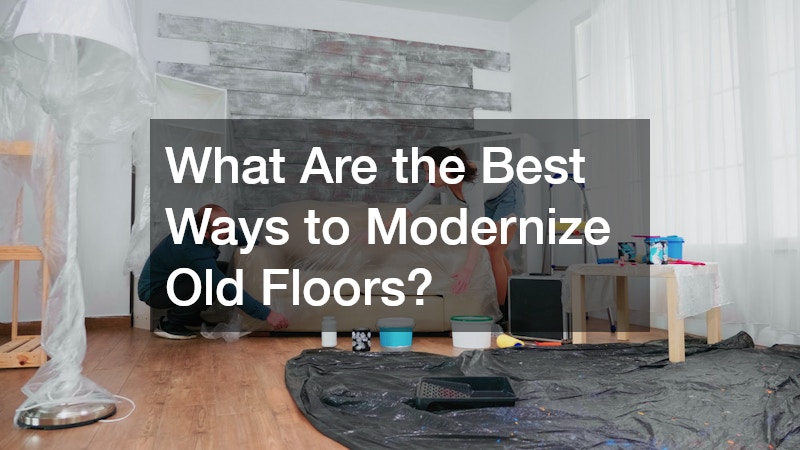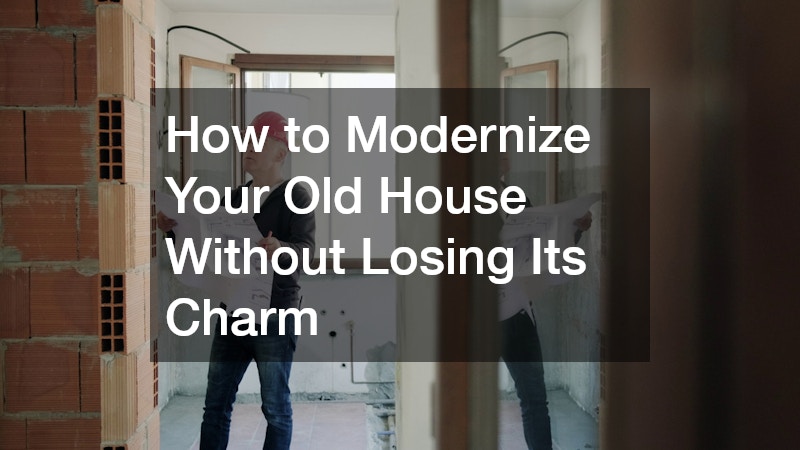In a world where modern aesthetics often reign supreme, the allure of an old house with its storied history and distinctive charm cannot be understated. To modernize an old house without losing its unique character involves a delicate balancing act. It requires carefully considering both the preservation of original features and the incorporation of contemporary conveniences. As homeowners seek to enhance both the functionality and aesthetic appeal of their houses, it’s crucial to respect and maintain the historical and personal elements that make their homes unique. Thoughtful modernization of an old house is not about trading charm for convenience but merging the best of both worlds. In this article, we will delve into various methods to accomplish this task, offering insights and guidance on how to navigate the complexities of modernizing an old home while preserving its inherent character.
Can I Modernize My Old House Without Destroying Its Historical Value?

Yes, modernizing your old house while preserving its historical value is very much possible. The key lies in being respectful of the original architecture and character. Start by identifying the historical features that need to be preserved, like crown moldings, original woodwork, or unique architectural details. By working with experienced patio services, you can enhance your outdoor living space while keeping the house’s historical style intact.
One approach to modernization is to maintain the shell and structure of the house while upgrading its interior amenities. This can include adding more efficient heating systems or modernizing the kitchen and bathrooms. Lighting contractors can play an essential role in this aspect, ensuring that new lighting fixtures complement the old-world charm while providing better functionality.
When tackling updates, consider enlisting the expertise of specialists in historical preservation. These professionals understand the significance of historical value and can offer advice on achieving a modern look without unsettling architectural balance. Remember that a respectful modernization is about bringing in contemporary comforts while honoring the past, creating a harmonious fusion of old and new.
What Are Some Stylish and Functional Modern Upgrades?
Modern upgrades should provide more than just an aesthetic facelift; they need to enhance the functionality of your home as well. One effective approach is to update the lighting schemes throughout the house. Lighting contractors can help integrate systems that offer versatile lighting options, from warm ambient lights to task-specific LED setups, all while ensuring the fixtures suit the historical context of your old house.
Smart home technology is another functional upgrade that brings modern conveniences into an old house without compromising its charm. Voice-controlled thermostats and lighting systems can increase your home’s efficiency and comfort. To keep things cohesive, choose smart devices with designs that are minimalist and subtle, ensuring they blend seamlessly with the existing aesthetics.
Finally, consider energy-efficient windows and insulation methods as significant improvements. These upgrades reduce energy consumption and enhance comfort within the home. By working with a roofing company, you can ensure that your roof is not only energy efficient but also in line with the historical style of your property. Such modern upgrades substantially improve daily living standards without detracting from existing architectural elegance.
How Can I Update My Interiors While Preserving Original Elements?
Updating the interiors of an old house requires finesse and careful planning. The aim is to integrate new features with preserved original elements seamlessly. Start by accentuating the existing charm—highlight elements like original fireplaces, hardwood floors, or vintage hardware. Working with skilled archway contractors, for instance, can help restore and highlight archways, adding to the architectural beauty of your interiors.
Ensure that new furnishings and interior decor complement the house’s historical aesthetic. Opt for a classic-modern blend by mixing vintage pieces with select modern furniture that respects the overall style. Choose colors and materials that echo the original building, ensuring that every modern piece feels like a part of the historical narrative.
When considering layout changes, it’s essential to minimize alterations to the core structure. Instead, work within the existing framework, using design solutions like open shelving or retractable features to create a modern feel. This approach allows for a more modern and functional interior without compromising historical elements, providing the best of both worlds.
What Are the Best Ways to Upgrade Outdated Plumbing and Electrical Systems?

Upgrading plumbing and electrical systems is often necessary to ensure safety and functionality in old houses. However, these updates must be made with sensitivity to the overall design of the home. First, a comprehensive inspection should be carried out by professionals, such as deck builders who may uncover additional concerns linked to outdated systems during renovations.
When replacing plumbing, consider the impact on historical features. Wherever possible, keep visible piping that adds character, opting for updates that are out of sight, such as inside walls or under floors, to preserve the vintage ambiance. It’s crucial that these updates comply with local building codes while respecting the aesthetic and structural integrity of historical homes.
Similarly, for electrical systems, the focus should be on safety and efficiency. Update wiring to handle modern loads and ensure that outlets and switches blend with the historical setting. By consulting with experts, you can maintain the look of antique fixtures while enjoying the benefits of modern electricity. These systematic updates ensure your home is both safe and functional while respecting its historical stature.
How Can I Improve My Home’s Energy Efficiency While Keeping Its Charm?
Enhancing energy efficiency in an old house helps reduce utility costs and environmental impact without sacrificing its timeless appeal. Begin by evaluating your home’s insulation and windows, key areas where energy loss may occur. A roofing company can provide consultations and services that improve your home’s insulation and aesthetics, with energy-efficient materials keeping the historical profile in mind.
Installing programmable thermostats and modern HVAC systems can also significantly decrease energy consumption. These advancements allow for better temperature control while remaining discreet within the home’s interior. Look for low-key installations that perform well without overshadowing the aesthetic attributes of your charming old home.
Another consideration is lighting—upgrading to LED bulbs and fixtures drastically improves energy efficiency. While working with lighting contractors, opt for fixtures that meet both your aesthetic and efficiency needs. These energy improvements modernize your home in a way that supports its historical charm while embracing contemporary sustainability standards.
Which Modern Kitchen Renovations Can Enhance Functionality Without Losing Character?
Kitchens are often central to modern home life, necessitating updates that increase efficiency while preserving alluring historic features. Start by retaining the character-defining elements, such as original moldings, cabinetry, or exposed beams. Consult with a painting company to refresh these features, using colors that highlight the kitchen’s historical elements.
When incorporating modern appliances, choose ones with retro designs or bespoke built-ins that suit the kitchen’s overall aesthetic. Ensure your new kitchen layout is functional, allowing for easy movement while cooking. Skilled kitchen designers can blend modern conveniences like quartz countertops or induction cooktops with classic aesthetics to avoid disrupting the historical ambiance.
Additionally, consider integrating countertop solutions for updated usability. Options like in-counter lighting and cutting boards can help maintain a modern functional space while marrying old-world charm. Using these strategies ensures the kitchen remains the heart of the home—a place where family history meets contemporary lifestyle.
What Are the Best Ways to Modernize Old Floors?

Old floors carry with them the patina of time, often offering a distinctive charm that modern materials strive to reproduce. However, modernizing a historic floor necessitates careful consideration to ensure the warmth and character are preserved. Repairs should focus on retaining as much of the original material as possible—consulting concrete contractors can help facilitate this balance in areas where modern foundation work might be necessary.
Refinishing existing wood floors is an essential step. Choose a finish that complements the wood’s natural grain while enhancing its durability and longevity. The new finish should act as a protective layer while maintaining the floor’s classic appearance. If restoration is not feasible, replacement boards should match existing styles to retain continuity.
For areas such as bathrooms or basements, elements like heated floors can provide warmth and comfort. These modern touches, concealed beneath period-appropriate flooring, add luxury without detracting from the antique allure. By blending careful restoration with smart updates, your home’s floors will continue to tell the stories of both the past and present.
How Can I Transform My Old Bathroom Into a Modern Oasis?
Transforming an old bathroom into a modern oasis requires skillful integration of contemporary comforts with vintage elements. Initially, focus on maintaining the distinct period features, such as claw-foot tubs or pedestal sinks, which provide visual interest and historical context. The delicate craftsmanship of these pieces often resonates well with modern updates, adding authenticity and charm.
Upgrade lighting and ventilation to modern standards by utilizing subtler fixtures. A shutter company can assist you with installing stylish window treatments that allow for controlled natural lighting and privacy while maintaining an antique feel. Consider adding recessed lighting or elegant sconces that enhance visibility without clashing with classic details. Select plumbing fixtures that echo traditional design but possess the efficiency and convenience needed for today’s lifestyle.
Additionally, explore materials that merge durability with aesthetic appeal—like marble countertops, subway tiles, or brushed brass finishes—to create a cohesive design. Finally, focus on maintaining a neutral color palette that complements both modern elements and historical features, creating a seamless blend. Incorporate contemporary amenities such as underfloor heating, smart mirrors, and high-efficiency toilets to bring comfort into focus while not overpowering the historical nature of the space. This balanced approach results in a bathroom that feels timeless, functional, and perfectly aligned with modern living.
How Do I Choose a Color Palette That Reflects Modern Trends Without Overpowering Original Style?
Choosing an appropriate color palette is crucial for maintaining a home’s period charm while infusing modern aesthetic sensibilities. Begin by acknowledging the original colors used in your home, which often reflect its historical era. A harmonious color palette will respect this heritage while introducing contemporary influences.
It is essential to work with neutral bases to achieve a cohesive balance. Painting companies can help achieve a modern look by suggesting complementary neutrals that highlight architectural details without overshadowing them. Consistency is key, as a unified palette across your interiors helps interweave modernity and history gracefully.
Lastly, consider accent colors that respect the home’s historical context. Use color to highlight architectural features such as moldings or original woodwork. Incorporate touches through textiles and furnishings, ensuring they play a subtle role that doesn’t detract from your home’s authentic charm. Landscape designers can also assist by suggesting outdoor palettes that extend the harmonious transition from interior to exterior artsy since maroon clash.
What Should I Consider When Altering the Layout of an Old House?

Altering the layout of an old house offers an opportunity to enhance functionality and flow, but it requires a delicate approach. First, understand the historical layout elements, like room size and placement, which were reflective of past needs and cultural contexts. Maintaining core features such as staircases or original walls is often advisable.
Before making structural changes, consult with backyard designers or architects familiar with heritage properties. Their insights can guide you through alterations that respect both the architectural essence and necessary modern lifestyle adjustments. It is important to preserve the unique patterns of space utilization that contribute to your home’s individuality.
Lastly, be mindful of the scale and proportion when altering layouts. Ensure that new spaces meld with existing ones, preserving the old home’s rhythm and flow. This process will enable a cohesive, functional, and delightful living environment that maintains the old-world charm while incorporating modern needs, utilizing 0 as a thoughtful enhancer.
The journey of modernizing an old house is both rewarding and challenging. It involves navigating between embracing contemporary living standards and preserving the unique historical value that your home inherently possesses. The marriage of old and new creates a space that resonates with both past narratives and present living. As you contemplate renovations, ensure that every choice reflects a commitment to this delicate balance, employing 0 as a principle method through integration. Personalization, when done respectfully, allows for self-expression without eroding your home’s fundamental identity. Ultimately, this thoughtful approach provides a bespoke living space where every corner whispers stories of time well spent.
